Crozet - Saturday 24/12/2005
A word about our accompanying friends
The Southern Ocean can be a large, lonely place
at any time but in the run up to Christmas it can feel especially
isolated. Apart from e-mails from home and the camaraderie
on board the only other accompaniment we have is the wildlife.
Luckily birds are very plentiful and varied and so always
provides a source of interest during times on deck or up on
the bridge. We have also been lucky to have had several encounters
with whales and dolphins which always livens up a day.
We normally have about 10-30 birds behind the
ship, following us round hoping we will throw over some scraps.
White-chinned Petrels, Northern Giant Petrels, Black-browed
Albatross and Wandering Albatrosses can always be found behind
the boat and there are normally some Black-bellied Storm Petrels
as well. The latter looking tiny amongst the albatrosses,
which have a wingspan 20 times greater! The birds will investigate
any kit we have in the water, mostly to see if there is any
food going but also it seems out of curiosity at times. They
get the kitchen scraps after meals and also the fish that
come up in the trawls, after they have been measured and weighed.
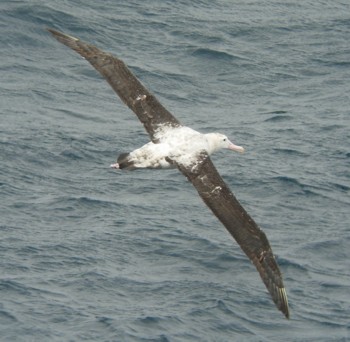 Wandering Albatross
Wandering Albatross |
|
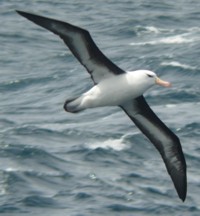 Black-browed Albatross
Black-browed Albatross |
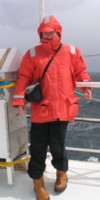 Scientist (for scale)
Scientist (for scale) |
The albatrosses give
the impression of being quite intelligent and are
definitely social with birds gathering together, rubbing
bills, preening each other and displaying to each
other by opening their wings so the white undersides
catch the sun – they act more like dogs than
birds in some ways. It seems such a shame that such
amazing birds are being killed at such a rate (100,000
a year) by long-line fishing. For more details see
www.savethealbatross.net |
 White-chinned Petrel
White-chinned Petrel |
|
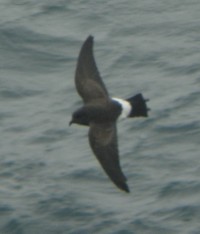 Black-bellied Storm-Petrel
Black-bellied Storm-Petrel |
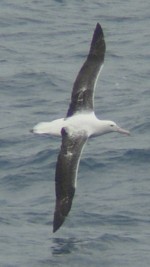
Southern Royal Albatross |
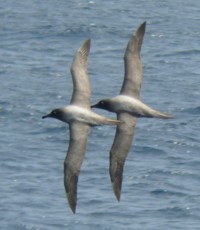
Light-mantled Sooty Albatrosses (in display flight) |
|
There is a huge (by open ocean standards)
diversity of other species with 32 seen so far away
from South Africa. The Crozet Islands have one the highest
numbers of breeding seabird species of any island group
in the world, presumably due to its location close to
warmer waters to the north but still within range of
the Polar Front and very cold seas to the south. The
area has not been visited often though so there are
still new things to be found – there are plenty
of Southern Royal Albatrosses around despite there apparently
being no previous records from the area and a Barau’s
Petrel (from Reunion Island) may be the first seen in
the Southern Ocean. |
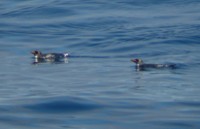
Macaroni Penguins |
The strong winds that
cause us so much problem with our work are a benefit
to the birds as they can use the winds and surface effects
(updrafts off waves and wind shear) to cover huge distances
with minimal effort – gliding only takes 5% of
the energy of flapping flight. This allows birds to
range over 1000 miles from their breeding sites on feeding
trips. Penguins also range a surprising distance - we
are over 150 miles from land but there are still plenty
of King Penguins and some Macaroni Penguins around though
they are very hard to spot unless the sea is quite calm
(which has happened once). |
Calm seas also help for
finding whales and two Fin Whales were seen 300 metres
in front of the ship during the calm period. The most
impressive sight though has been the 150+ Long-finned
Pilot Whales that surrounded the boat for 4 hours while
we were hove to in strong winds, these being joined
briefly by 40+ Southern Rightwhale dolphins. Other sightings
have included a Sperm Whale, 7 Humpback Whales and 3
groups of Common Dolphins close to South Africa, some
coming in and riding the bow wave. Other wildlife has
included a Turtle and a Marlin close to Durban and some
flying fish in the warm waters at the beginning of the
passage out here.
|
|

Rightwhale Dolphin |
 Humpback Whale
Humpback Whale |
|
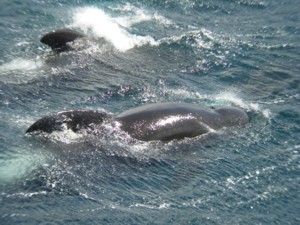
Pilot Whales |
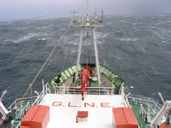 |